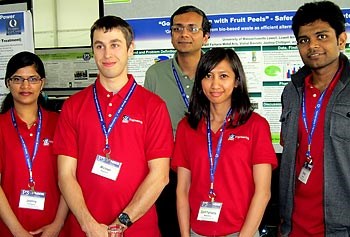Team Receives Grant for Developing ‘Greener’ Cleaning Agents

From left, Joshna Chittigori, Michael Magaletta, Assoc. Prof. Ramaswamy Nagarajan, Zarif Farhana Mohd Aris and Vishal Bavishi pose with their research poster during Phase II of the EPA's P3 competition in April in Washington, D.C.
06/28/2013
By Edwin L. Aguirre
A group of UMass Lowell student researchers is among seven teams from six colleges and universities across the country that won the prestigious “P3” — People, Prosperity and the Planet — award from the U.S. Environmental Protection Agency (EPA).
The teams were recognized for their work in designing environmental solutions that will help improve quality of life, promote economic development and protect the environment. Each team receives up to $90,000 to further develop their designs and ideally bring them into the marketplace.
UMass Lowell won the funding for creating safer, effective, non-toxic and biodegradable surfactants from abundant, renewable resources — namely, fruit-peel waste and sea algae. Surfactants are cleaning agents found in millions of everyday products such as household laundry detergents, personal care products, cosmetics and industrial cleaners. They help remove dirt, oil, grease, food and other organic compounds from clothes and dishes by making the dirt and oil dissolve more readily in water during washing.
“This award helps inspire a new generation of scientists and engineers to create solutions to complex environmental problems,” says Curt Spalding, regional administrator for the EPA’s New England office. “UMass Lowell students are playing a leadership role, applying their ideas to real-world situations and playing a part in protecting the environment in a more sustainable way.”
Members of the team include Zarif Farhana Mohd Aris, a Ph.D. candidate in plastics engineering; Vishal Bavishi, a master’s degree student in plastics engineering; Joshna Chittigori, a Ph.D. candidate in chemistry, and Michael Magaletta, a junior in plastics engineering.
“The EPA’s support for this research on surfactants will allow our students to continue their promising work to convert plant-based materials into products that can eventually replace toxic ingredients in cleaning products globally,” says Plastics Engineering Assoc. Prof. Ramaswamy Nagarajan, who is the team’s faculty adviser.
The other P3 award winners include teams from Cornell University, Loyola University of Chicago, Radford University, San Jose State University and Georgia Southern University.
A ‘Greener’ Approach to Cleaning
“Many of the surfactants used commercially today are petroleum-based,” says Mohd Aris, the team’s lead researcher. “They are either non-biodegradable or they break down to produce more toxic products such as nonylphenol ethoxylates, or NPEs.”
“These persistent chemical compounds can build up in rivers and streams, poisoning aquatic life,” adds Nagarajan. “They can also find their way up the food chain to humans. NPEs have been linked to developmental and reproductive disorders and are suspected of disrupting the body’s hormone system.”
Although NPEs have been phased out of detergents in Europe and Canada, only a few states in the United States have implemented this requirement, he says.
The team has already won a number of grants and awards for its efforts. In 2010, it received a two-year, $25,000 seed grant from the Toxics Use Reduction Institute (TURI) to determine if the team’s formulation for the bio-based surfactants can help eliminate NPEs from laundry operations.
In the spring of 2012, Nagarajan and his team received a $25,000 grant from the UMass Commercial Ventures & Intellectual Property (CVIP) Technology Development Fund, which they used to scale up the process and buy new equipment.
And in August of that year, the team was one of 45 winners nationwide in the (http://yosemite.epa.gov/opa/admpress.nsf/d0cf6618525a9efb85257359003fb69d/ab8c3af154e5775e85257aca004e1fd6!OpenDocument) first phase of the EPA’s P3 award. The resulting $15,000 grant allowed students to further test their ideas in the lab and to compete for the $90,000 grant in the second phase of the competition.
“Our surfactants exhibit cleaning efficiencies similar to those of NPEs,” says Nagarajan. “We envision this technology to eventually replace NPEs in commercial products.”
Making-Packaging-Plastic-Biodegradable Making Packaging Plastic Biodegradable
In addition to the work on bio-based surfactants, UMass Lowell student researchers have also won Phase I of the 2013 EPA P3 award for a different project.
Bavishi, Mohd Aris and Magaletta, together with plastics engineering doctoral student Timothy Ponrathnam, received $15,000 for their work on developing a packaging solution that is bio-based, sustainable and economically viable.
Packaging is one of the major uses of plastics, accounting for more than 30 percent of the market. Plastic food-packaging films often require high resistance to moisture and oxygen to maintain freshness of the food for extended periods.
“Unfortunately, the bulk of the plastics used for flexible packaging are not biodegradable and end up polluting the land and sea if not properly recycled,” says Bavishi, the team’s lead researcher.
The researchers’ proposed process involves coating the polymer film being used today with combinations of biodegradable and bio-derived materials such as chitosan (from shells of crabs and shrimp), plant-derived fatty acids and nano clay to improve the film’s barrier properties. The coating process also uses environmentally friendly solvents (predominantly water).
“We envision this approach would provide a greener alternative to petroleum-derived non-biodegradable plastics used in commercial food packaging,” says Nagarajan.
The team is working hard to complete their research so they can vie for the $90,000 in grant money in Phase II of the P3 competition next year.
